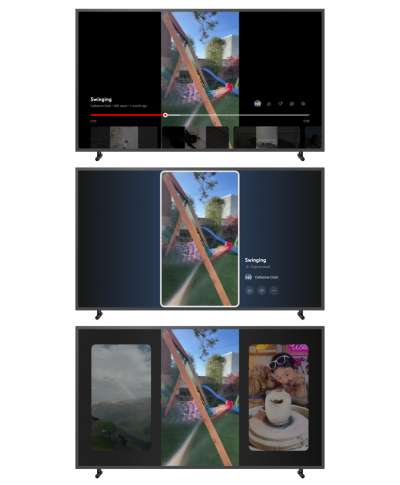YouTube Shorts – the mobile-first short-form video format that aims to challenge TikTok – is making its way onto a larger screen, now optimized for TV sets.
Google’s YouTube announced the expansion Monday, and Neal Mohan, chief product officer, noted it wasn’t a simple move to ensure an excellent user experience.
“While this may seem like a natural next step, an incredible amount of thought and care has gone into bringing this vertical, mobile-first experience to the big screen,” Mohan stated in a blog.
YouTube Shorts are video clips that are 60-seconds or less. In picking the style of how video would be displayed on the larger screen, YouTube decided to forgo its traditional player, or as a second option a so-called “Juke Box” format that would’ve utilized the extra space a TV offers by showing three simultaneous Shorts side-by-side. Based on consumer feedback it landed on one video in the center screen, saying a customized option better fills space on both sides of the video.

When it comes to design, ultimately YouTube decided to go with a format that on the right side show features people have come to know from Shorts such as comments, community actions (to like or subscribe) and finding related videos – it doesn’t appear that all of those will be available at the start, but YouTube expects to increase functionality features in future releases.
Interestingly, YouTube said it decided not to have Shorts autoplay, as consumers said they prefer the method of using a remote to manually advance to the next video.
“Typically we find that level of interactivity can be tedious with a remote, but in this case, short-form video is unique,” the blog noted. “Research indicated that people want to take charge of the viewing experience — just like with Shorts on mobile — and even expected it.”
YouTube Shorts will be rolling out on model year 2019 and later smart TVs, streaming devices and on newer gaming consoles.
In researching the main benefits and drawbacks of bringing Shorts to larger screens, YouTube said viewers enjoy the community experience of watching with friends and family on a TV, but felt the native mobile form on TVs could be clunky, slow loading, or lacking key features such as sharing.
To access Shorts on smart TVs users need to open the YouTube app. From there they navigate to the Shorts shelf, or go to a creator’s page, select the Short and use their remote to play the video. Using the TV remote viewers can also pull up info on the title, creator and what sound is being used. Viewers can then scroll down to view their next Short or scroll up to see the previous one.
YouTube Shorts’ jump to the larger screen comes as the company eyes monetization of the short-form videos. During Q3 earnings, YouTube reported its first-ever quarterly advertising sales decline, and executives took time to highlight the opportunity of Shorts.
“It’s still early but we’re encouraged by the progress we’ve made this year in Shorts monetization and support for sustaining the creator ecosystem,” said Philipp Schindler, SVP and chief business officer at Google, during the earnings call.
YouTube providing additional viewing options and bringing Shorts to TVs also comes as the platform looks to compete against short-form video giant TikTok. The TikTok app has already made its way into smart TVs, including an integration earlier this year on Vizio TV sets. Last year TikTok added Google TV and Android TVOS devices, and LG and Samsung to its list of app distribution partners, as well as Amazon Fire TV in North America.
The integration with Vizio was custom, with TikTok content highlighted in a carousel on the smart TV home page and the ability to watch videos without having to sign in or download extra apps. While it shows curated genres of TikTok content in the carousel Vizio’s Katherine Pond told Parks Associates’ Eric Sorensen those tiles could eventually evolve based on algorithms related to content viewing preferences.
In an August column for Fierce Video, Sorensen discussed the partnership, saying viewing social media on the big screen isn’t new but curated genres based on viewing habits on the living room TV is.
“TV manufacturers, aggregators, and all OTT services are looking for ways to simplify the consumer's discovery process,” wrote Sorensen. “These personalized social viewing experiences on streaming and connected TV environments might just simplify the content discovery process.”
Meanwhile, YouTube is also beefing up its own platform. Just last week it debuted a streaming subscription aggregation service, Primetime Channels, where users can find, subscribe to and watch over 30 services, including Paramount+, Showtime, and AMC+, among others – directly on the YouTube platform.